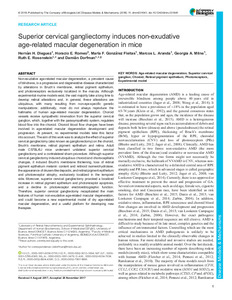Por favor, use este identificador para citar o enlazar este ítem:
https://repositorio.uca.edu.ar/handle/123456789/8621| Título: | Superior cervical gangliectomy induces non-exudative age-related macular degeneration in mice | Autor: | Dieguez, Hernán H. Romeo, Horacio González Fleitas, María F. Aranda, Marcos L. Milne, Georgia A. Rosenstein, Ruth E. Dorfman, Damián |
Palabras clave: | DEGENERACION MACULAR; GANGLIOS; RETINA | Fecha de publicación: | 2018 | Editorial: | Company of Biologists | Cita: | Dieguez HH, Romeo HE, Fleitas MFG, et al. Superior cervical gangliectomy induces non-exudative age-related macular degeneration in mice [en línea]. Disease Models & Mechanisms. 2018;11(2):dmm031641. doi:10.1242/dmm.031641 Disponible en: https://repositorio.uca.edu.ar/handle/123456789/8621 | Resumen: | Abstract: Non-exudative age-related macular degeneration, a prevalent cause of blindness, is a progressive and degenerative disease characterized by alterations in Bruch's membrane, retinal pigment epithelium, and photoreceptors exclusively localized in the macula. Although experimental murine models exist, the vast majority take a long time to develop retinal alterations and, in general, these alterations are ubiquitous, with many resulting from non-eye-specific genetic manipulations; additionally, most do not always reproduce the hallmarks of human age-related macular degeneration. Choroid vessels receive sympathetic innervation from the superior cervical ganglion, which, together with the parasympathetic system, regulates blood flow into the choroid. Choroid blood flow changes have been involved in age-related macular degeneration development and progression. At present, no experimental models take this factor into account. The aim of this work was to analyze the effect of superior cervical gangliectomy (also known as ganglionectomy) on the choroid, Bruch's membrane, retinal pigment epithelium and retina. Adult male C57BL/6J mice underwent unilateral superior cervical gangliectomy and a contralateral sham procedure. Although superior cervical gangliectomy induced ubiquitous choroid and choriocapillaris changes, it induced Bruch's membrane thickening, loss of retinal pigment epithelium melanin content and retinoid isomerohydrolase, the appearance of drusen-like deposits, and retinal pigment epithelium and photoreceptor atrophy, exclusively localized in the temporal side. Moreover, superior cervical gangliectomy provoked a localized increase in retinal pigment epithelium and photoreceptor apoptosis, and a decline in photoreceptor electroretinographic function. Therefore, superior cervical gangliectomy recapitulated the main features of human non-exudative age-related macular degeneration, and could become a new experimental model of dry age-related macular degeneration, and a useful platform for developing new therapies. | URI: | https://repositorio.uca.edu.ar/handle/123456789/8621 | ISSN: | 1754-8403 (print) 1754-8411 (online) |
Disciplina: | MEDICINA | DOI: | 10.1242/dmm.031641 | Derechos: | Acceso Abierto | Fuente: | Disease Models & Mechanisms. 2018;11(2):dmm031641 |
| Aparece en las colecciones: | Artículos |
Ficheros en este ítem:
| Fichero | Descripción | Tamaño | Formato | |
|---|---|---|---|---|
| superior-cervical-gangliectomy-induces.PDF | 21,28 MB | Adobe PDF |  Visualizar/Abrir |
Visualizaciones de página(s)
295
comprobado en 26-dic-2025
Descarga(s)
258
comprobado en 26-dic-2025
Google ScholarTM
Ver en Google Scholar
Altmetric
Altmetric
Este ítem está sujeto a una Licencia Creative Commons

